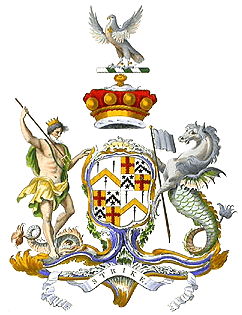Baron Hawke

Baron Hawke, of Towton in the County of York, is a title in the Peerage of Great Britain. It was created on 20 May 1776 for the admiral Sir Edward Hawke, in charge of a blockade of all French merchant shipping and the grounding of six French Ships, and scattering of the rest, at the battle of Quiberon Bay. The battle followed an earlier British victory at the Battle of Lagos off Portugal by a fleet under another Admiral's command.
The year, 1759, was dubbed for Britain its Annus Mirabilis or 'miracle year' as France could not follow up on clear victory in the Battle of Sainte-Foy in what is now Canada in 1760 for want of reinforcements and supplies from France, and its crippled trade triggered a credit crunch. Hawke's naval conduct then and later as Lord Admiral proved to establish British naval supremacy and in the immediate term determined the fate of New France and hence Canada.[1]
His son, the second Baron, represented Saltash in the House of Commons for the six years until his father died. His son, the third Baron, assumed the additional surname of Harvey.
The fifth Baron succeeded his elder brother in 1869 and in the next year was succeeded by his first cousin, the sixth Baron. He was the son of Hon. Martin Bladen Edward Hawke (Jnr). His son, the seventh Baron, an exceptional cricketer, became the England cricket team captain. On his death the title passed to his younger brother, the eighth Baron. His elder son, the ninth Baron, was one of six to eight co-serving Lords whips in the Third Churchill ministry and two following Conservative ministries until 1964.
He was succeeded by his younger brother, the tenth Baron, whose son then became the 11th Baron on his death.
As of 2014 the title is held by the 12th Baron, who succeeded his father in 2010.
Barons Hawke (1776)
- Edward Hawke, 1st Baron Hawke (1710–1781)
- Martin Bladen Hawke, 2nd Baron Hawke (1744–1805)
- Edward Harvey-Hawke, 3rd Baron Hawke (1774–1824)
- Edward William Harvey-Hawke, 4th Baron Hawke (1799–1869)
- Stanhope Harvey-Hawke, 5th Baron Hawke (1804–1870)
- Edward Henry Julius Hawke, 6th Baron Hawke (1815–1887)
- Martin Bladen Hawke, 7th Baron Hawke (1860–1938)
- Edward Julian Hawke, 8th Baron Hawke (1873–1939)
- Bladen Wilmer Hawke, 9th Baron Hawke (1901–1985)
- Julian Stanhope Theodore Hawke, 10th Baron Hawke (1904–1992)
- Edward George Hawke, 11th Baron Hawke (1950–2009)
- William Martin Theodore Hawke, 12th Baron Hawke (b. 1995)
There is no heir to the barony.
Coat of arms
_(geograph_2691576).jpg)
- Arms: Quarterly 1st and 4th argent, a chevron erminois between three boatswain's whistles purple, 2nd and 3rd grand-quarter quarterly, 1st and 4th or, a cross engrailed gules, 2nd and 3rd argent, a chevron engrailed sable, three mullets sable.
- Crest: A hawk rising ermine, beaked, belled and charged on the breast with a fleur-de-lis or.
- Supporters: Dexter, Neptune, his mantle of a sea-green colour, edged argent, crowned with an eastern coronet or, his dexter arm erect, darting downwards, his trident sable, headed silver, resting his sinister foot on a dolphin proper; sinister, a seahorse or, sustaining in his forefins a banner argent, the staff broken proper.
- Motto: Strike.
Bibliography and references
- ↑ Syrett (ed.). The Royal Navy in European Waters During the American Revolutionary War. p. 59.
- Middleton, Richard (1985), The Bells of Victory: The Pitt-Newcastle Ministry and the Conduct of the Seven Years' War, 1757–1762, Cambridge University Press.
- Mackay, R.F. Admiral Hawke (Oxford 1965).
- Montague Burrows: The Life of Edward Hawke, Lord Hawke, Admiral of the Fleet: with some accounts of the origin of the English Wars in the reign of George II. Published (1883).
References
- Kidd, Charles, Williamson, David (editors). Debrett's Peerage and Baronetage (1990 edition). New York: St Martin's Press, 1990,
- Leigh Rayment's Peerage Pages